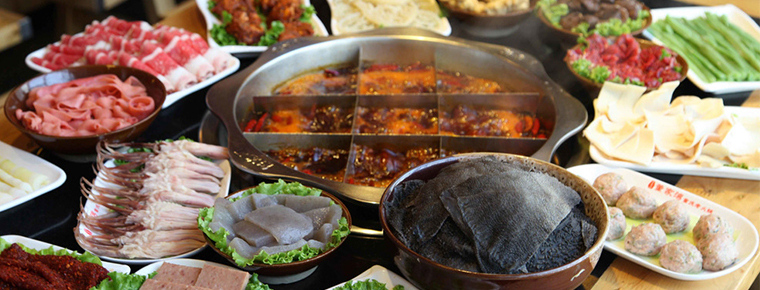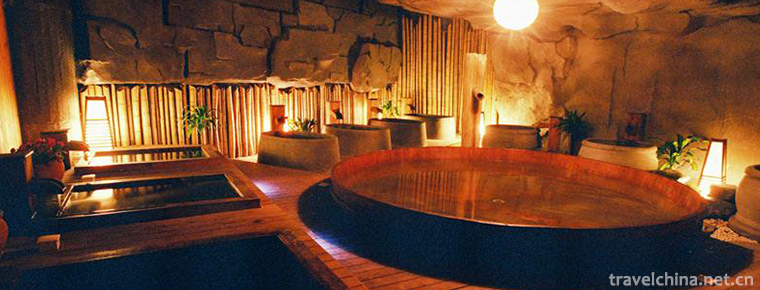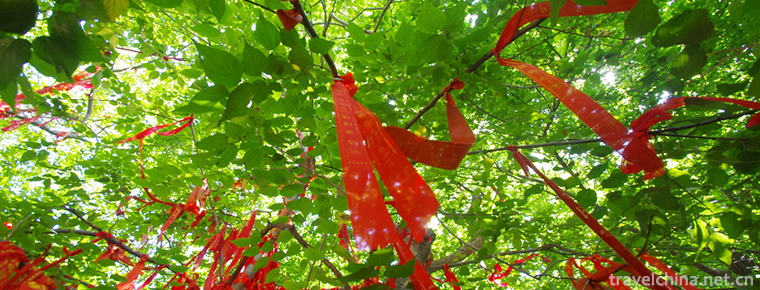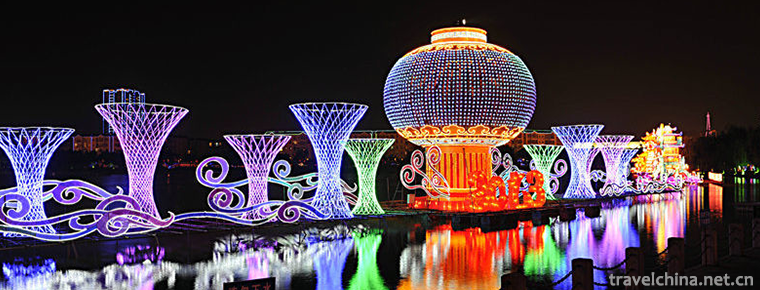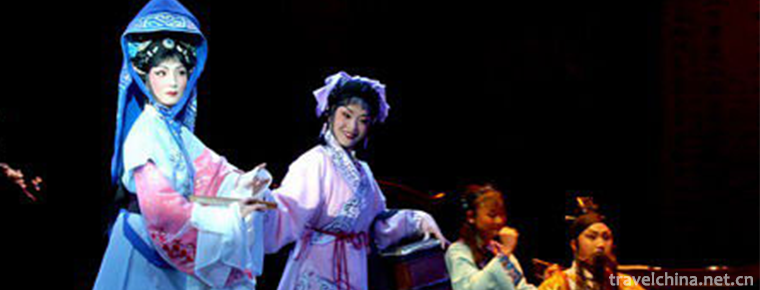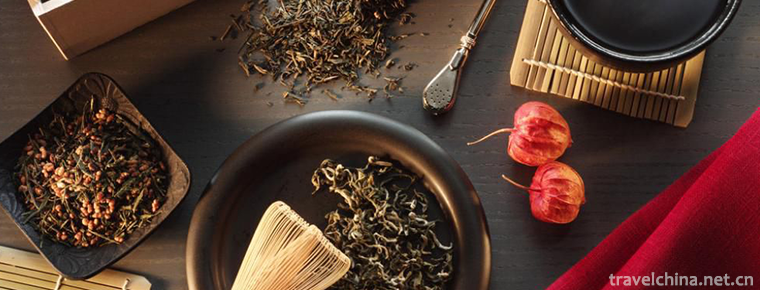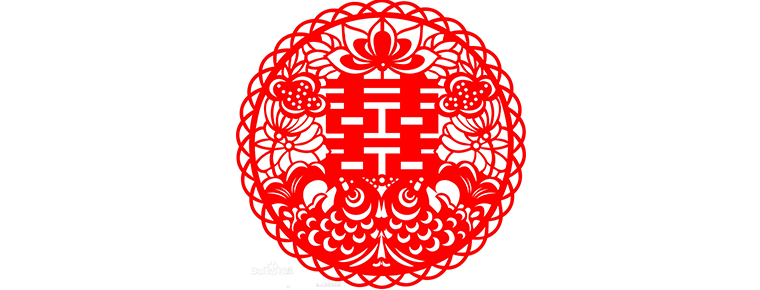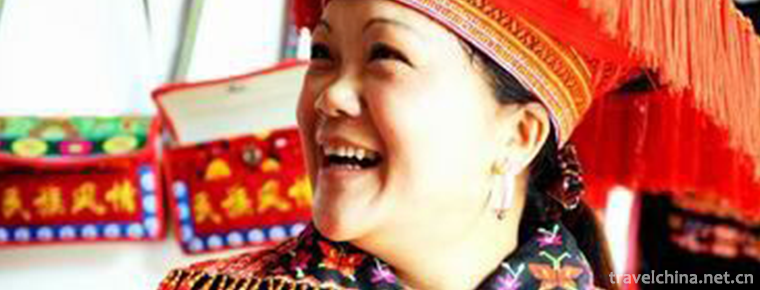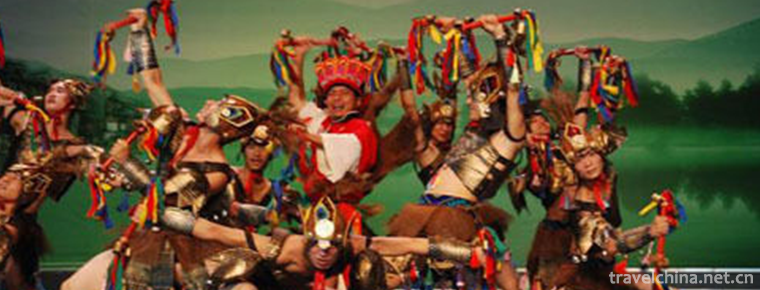Quanzhou North Pipe
Quanzhou North Pipe
Beiguan, also known as Beiqu, Xiaoqu, Quzi, is a kind of traditional folk silk and bamboo music widely spread in Quangang District, Quanzhou City, Fujian Province. China's Beiguan is now only distributed in Quanzhou, so it is collectively called "Quanzhou Beiguan", and the "living fossil of ancient music" Nanyin, also known as "sister flower", known as "the voice of the Son of Heaven". It belongs to the same kind of music as Beidou in central Taiwan, Ryukyu Music in Japan and Beidou Music in Southeast Asia.
In 2006, it was listed in the first national intangible cultural heritage catalogue by the State Council. In 2014, Quangang District was awarded the "Town of Music and Culture of China's North Pipe".
Brief Introduction of North Guan
Legend has it that the folk music of the Yangtze and Huaihe areas in the Ming and Qing Dynasties was introduced by sea transportation, salt soldiers in the South and refugees in the Huaihe River, which was also called "Nanguan" (Nanyin) as "Nanxianbeiguan". North Guan of mainland China is now only distributed in Quanzhou, so it is collectively called "Quanzhou North Guan".
geographical position
Quangang (North Gate of Quanzhou) is located on the south coast of Meizhou Bay, near Hong Kong and Macao, facing Taiwan. It is the intersection zone of the two languages of Fujian and Puxian. It is also the transitional zone between the southern Fujian folk music color area and Puxian color area. It has Nanyin, Gaojia Opera, Puppet Opera, Puxian Opera and other folk music forms. Beiguan is a wonderful folk music that grew up in this special geographical position and artistic atmosphere. It originated from outside the province and multiplied in Quangang. It blended and permeated with local folk music. It evolved into a new type of music that not only retained the style of folk music in the area of Jianghuai, but also softened into some characteristics of Southern Fujian and Puxian music, and also had the local characteristics of Quangang.
The unique artistic style and characteristics of this kind of music have attracted the attention of many music experts and scholars at home and abroad in recent years, and have been praised and affirmed by the news media. Music experts from the United States, Britain, Japan, Taiwan and the Mainland of China have flocked to explore its historical origin and artistic style. Wang Yaohua, a famous national musician, said in his "Fujian Traditional Music" that "Beiguan, a kind of music popular in Hui'an County, the hinterland of Fujian Nanyin, can compete with the ancient music of Nanyin, which has a long history, and can exist for a long time. It shows that its vitality is tenacious and its artistic appeal is tremendous."
North Management Classification
North tube is divided into two categories: music and music. Music is vocal music and music is instrumental music. Most of the songs originated from Jianghuai minor since Ming and Qing Dynasties, and most of the scores originated from Guangdong music, Jiangnan silk bamboo and Peking Opera.
The lyrics are mainly narrative lyrics and scenery lyrics. At the end of the phrases, passages and music, there are often the lining words "Ouch". Mandarin is used in singing (Huguang dialect, equivalent to modern common dialect). In the prelude and phrase of the song, singers often accompany the music by playing percussion instruments while singing, which adds a lot of vitality to the music. Some singing methods of music and Nanyin make the singing loud, powerful, melodious, gentle and beautiful.
In music performance, gongs and drums are generally not used, but slabs or wooden fish drums are used to beat hard, playing mainly the common folk "branch tone polyphony". String instruments mostly use short bows, one bow and one tone, and slightly change on the basis of the main backbone tones, and embellish them with "variation, change palace". In the form of music structure, it is common to combine several pieces of music with cards, and there is also a form of music structure which is composed of plate changing techniques.
style of music
After the popularity of Beiguan in Huibei (now Quangang District), famous artists Liu Ajiu, Liu Jinjiu and Liu Jianjiu appeared.
In 1882, Liu Ajiu was invited to participate in the outing of "sending Confucius" in Quanzhou, which shocked the audience. Quanzhou Prefecture declared its constitution and granted "You Sheng" to attend school, and named it Dance Hall. The annual "Send Confucius" dance hall was invited to attend the meeting. Since then, Beiguan has been highly praised by local officials and scholars. In order to distinguish it from Nanguan, Beiguan, a music originating from other places, has been called Beiguan.
Beiguan music style not only retains the clarity and elegance of folk songs in Jianghuai area, but also joins the gentleness and elegance of southern Fujian and Puxian music. It has strong and simple personality and the reputation of "the Son of Heaven" transmission. Its protection is of great significance to the study of the origin of Taiwanese Beiguan and Japanese imperial seat music, as well as the transition between Fujian folk music in southern Fujian and Puxian color areas.
Although Beiguan is an exotic form, it has been deeply rooted in Quanzhou Quangang area for hundreds of years. In the long-term singing and playing, Beiguan has been integrated with the surrounding Nanqu, Gaojia, Xianju and Puxian Opera, and influenced, infiltrated and assimilated by the confluence of southern Fujian and Puxian, gradually becoming a new kind of music different from its origin.
Quangang area is bordered by Xinghua (Putian, Xianyou). The original "Xinghua Music" (Puxian Music) is spread. In the process of dissemination, Beiguan combines some artistic methods of Xinghua Opera. It has the gentle and beautiful characteristics of southern Fujian and Puxian, and is a kind of music different from its origin. However, unlike the music of southern Fujian and Puxian, it basically retains the clear and elegant charm of folk songs in the Jianghuai area.
NORTH TUBE SPECTRAL FORMULA
The recording method of Beiguan is ruler spectrum, which takes "Shangchigong Fan 65B" as the basic note, but it is not exactly like ruler spectrum. For example, if the high octave or low octave in the word is not often used to pick up or down to express. The score of the North Wind is influenced by the performance, especially the stringed instruments. If it is necessary to play the notes below the first position, it is often replaced by homonyms eight degrees lower than it. Only "Sixth Five-Year Plan" two-tone low octave is represented by "Heshi", while the other "Shangchigong Fanyi" five-tone, regardless of the high octave and low octave are these words. After the artists have read the music well, they can deal with it freely according to their artistic feeling.
The slant eye (rhythm and rhythm) of the North Guanpu Spectrum is expressed by "X (strong)" and ". (weak)" while the sub-strong beat is expressed by "eyes". Repeated homonyms are represented by daggers, phrases and passages are collectively referred to as "clouds", crossing doors as "crossing points", and whole notes as "X...". Representation (i.e. the three strokes behind the board). Artists often use palm and finger strokes to indicate strength when they read music. Take the palm as "x (strong)" and the middle finger as "press". (Subdued strokes). The index finger and ring finger are pressed respectively "."(Weak). In the North Tube Plate, there are only "X" (1/4 shoot), one-sided "X" (2/4 shoot) and one-sided "X" (3-sided shoot). "
(4/4 shoots).
With the passage of time, Beiguanyi people realized the limitations of the tape notation. It is difficult to express in writing such as attachments and segmentation. If the time is long, the memory can not remember accurately. In order to record precious North Wind Music well in written form, artists absorbed some notation methods of simple notation in notation. But up to now, there is also a kind of north tube spectrum which has only a board but no other marks.
According to the veteran artists, in the past, bands used to "jigsaw" (referring to the competition between bands who sang (played) more music than others who could not play (sang) music, and showed a highly skilled form of competition). Only the head of the band knew how the music should be played (sung), while others did not know, or Only a little knowledge of one or two, lest the music be "stolen" by the people of other bands. This simplified North Guanpu obviously has some sense of prevention. It is a protective measure in the interests of its own music club, but in terms of the inheritance and exchange of art, it has a typical cultural closure.
North Guan School
From the artistic features and styles of Beiguan singing, we think that it can be divided into two major schools, and temporarily named as "south" and "north".
The Southern Style is also the Northern Orchestra of Shanyao Town, Qianhuang Town, Tuling Town and Shanyao Salt Farm in Jinquangang District. The dialect here focuses on the southern Fujian accent. People are more accustomed to appreciating and singing Nanyin and Xianju operas, and less accustomed to appreciating and singing Puxian songs. Therefore, when Southern artists sing Beiguan, they unconsciously, more or less integrate into the singing methods and styles of Nanyin and Xiangju operas. But it is a precious product that has been sublimated through fine screening, giving people a moderate natural and harmonious enjoyment of sound and beauty. The Southern Style is most representative of the North Mountain Wind Orchestra, whose bands are often equipped with small suona, Pipa and other ten-tone instruments commonly used in southern Fujian. Music is high and powerful, and the color is bright.
The Northern Style is also the Northern Orchestra of Fengwei Town, Houlong Town, Nanpu Town and Jieshan Town.
Most of the dialects here are "Toubei dialect" (a dialect in the transition zone between Minnan dialect family and Puxian dialect family, which is called "Toubei dialect" by local people), and a few other areas have belonged to Puxian dialect family. People in most areas here are accustomed to appreciating and singing Puxian songs. Therefore, it is unavoidable for Northern artists to blend the characteristics of Puxian style in their singing, but it is also a treasure that has been sublimated through fine screening. The North School is most representative of Guifeng North Wind Music Club. Its orchestra is often equipped with common instruments such as Du Chihu, Shuangqing and other ten tones of Puxian. The music is simple, soft and dim.
North wind instrument
The local people of the North Orchestra call them "chord" or "chord" teams. When invited to play (sing), they call them "out of the hall" or "out of music". The band mainly used the instruments of Jiangnan silk bamboo, and used Puxian and Minnan instruments, such as Sheng, duldulcimer, Dongxian, Pinxiao (flute), piano, Yuqin (short pole), Shuangqing, minor three stringes, violin (Beijing Hu), Mohu (Gaohu or Erhu), Banhu (coconut hu), steel hu, steel hu, rulehu, HuHu, Dahu, Banhu, Dagong, cymba, small cymba, big gong, big gong, big gong, gong, small gong, small gong, small gong, small gong, small gong, small gong, small gongong, small gongong, small gongong, small gongongong, small gongongong, Fish, drums, boards, etc. (After the Republic of China, music) The team seldom used Sheng, Yangqin, Dongxiao and other musical instruments. At present, its characteristic musical instruments are Chihu and Shuangqing, and its main musical instruments are string raising and chopping. In the early days, the band took part in the parade of making-up and greeting gods and other activities, with the drum-drum (there are plate drums, small hall drums, board, wooden fish and other percussion instruments) taking the lead, followed by cymbals, gongs and pipes, which were separated in turn, followed by strings, Mohu, Yueqin on the right, and ladle-hu, Shuangqing and Xiaosanxian on the left. In front of the band is playing the banner of "the Son of Heaven Propaganda", which is magnificent in contrast to Nanyin's "Qing Song before the Imperial Emperor".
Band Formation
The formation of the band is dominated by "walking style" and supplemented by "sitting style". "Sitting style" is only used to play in the cave and the ordinary room. There is no obvious requirement for the arrangement of musical instruments. Generally speaking, there are seven or eight people in the orchestra, and fifteen or six people in the orchestra. If there are more people, the Yueqin, Shuangqing and Pingxiao will be used in one pair, and other instruments will be at will. According to Liu Xibi, a famous North Orchestra artist, due to the different number of bands and instruments, it is impossible to seek unity in the collocation, but there is a basic principle, that is, a pair of pipes and drums, a small three-stringed band, and other instruments can be collocated freely according to the need.
In addition to Orchestra configuration, the fixed strings of northern orchestral instruments are also very special. They use the "sol" of each tune as the "standard sound" (Pingxiao is usually E, F, G tone). After the fixed strings, the naming of empty strings is borrowed from the naming method of empty strings of Puxian instruments (the empty strings of three strings, the folk fixed strings are often named by the first and second strings, and the third strings are the homonymous of the first and the third strings).
Current situation of inheritance
"At present, the old artists of Beiguan are getting older, and the income of Beiguan performances is small. They mainly rely on folk funerals and sitting and singing all night, which can not attract the attention of young people." As a representative inheritor of Quanzhou intangible cultural heritage project "Quanzhou Beiguan", Liu Zongxun was worried that the inheritance of Quanzhou Beiguan would be unacceptable and would be in danger of losing it. He called on both sides of the Straits to join hands and take effective measures to inherit this non-legacy culture from generation to generation.
Huang Jiahui, curator of the Cultural Museum of Quangang District, said that the protection and inheritance of the North pipe of Quangang are embodied in the ecological protection and the imparting of traditional skills. There are many similarities and similarities between Fujian and Taiwanese Beiguan. We can learn from each other. To discuss the protection and inheritance of Beiguan music on both sides of the Taiwan Strait will promote the development of Beiguan music in depth.
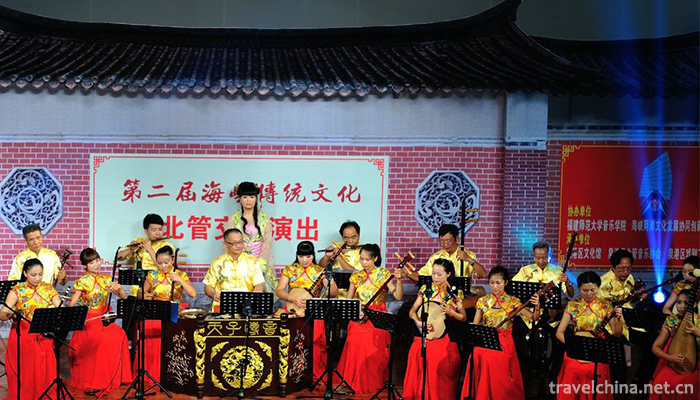
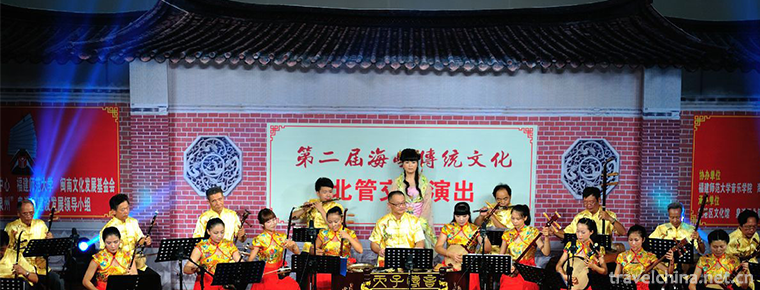
Quanzhou North Pipe
-
Dongshan Lake Hot Spring Resort
Dongshan Lake Hot Spring Resort is the first national AAAA-level scenic spot in Chaozhou City. It is located in the Dongshan Lake scenic spot of Shaxi Town at the junction of Chaozhou
Views: 159 Time 2018-12-19 -
Tsing Tan Temple
Qingdan Temple is located 3.5 kilometers west of Fucheng, Zaozhuang City, in the narrow valley of Chu and Han Mountains. It was built in the Tang Dynasty.
Views: 207 Time 2019-02-07 -
Exhibit of lanterns
The Lantern Festival is an ancient folk culture in China. It generally refers to the large-scale lighting exhibition held by the government around the Spring Festival and the Lantern Festival
Views: 180 Time 2019-04-26 -
Dian Opera
Yunnan Opera is one of the local operas in Yunnan Province. Silk string (originated from the earlier Qin Opera), Xiangyang (originated from the Xianghe School of Han Diao) and Huqin (originated from H
Views: 171 Time 2019-04-26 -
Black Tea Production Techniques
Black tea, originally known as "Border Tea", was smuggled across the border by merchants as early as the end of the 16th century. In the Ming Dynasty, black tea was designated as
Views: 130 Time 2019-05-03 -
Paper cut art
Chinese paper-cut is a kind of folk art that uses scissors or carving knives to cut patterns on paper, to decorate life or to cooperate with other folk activities. In China
Views: 307 Time 2019-05-05 -
Yao Costume
Yao people used to call themselves "Guoshan Yao", "Hongtou Yao", "Dabanyao", "Pingtouyao", "Blue Indigo Yao", "Shayao" and "Baitou Yao&
Views: 309 Time 2019-07-11 -
Youyang Folk Songs
Youyang folk song is a rich and colorful folk culture created and accumulated by the Tujia, Miao and Han people in Youyang Tujia and Miao Autonomous County of Chongqing in the long practice of product
Views: 145 Time 2019-07-14 -
Beijing Technology and Business University
Beijing University of Industry and Commerce is a multi-disciplinary university in Beijing. It was approved by the Ministry of Education in June 1999 by the merger of Beijing Institute of Light Industr
Views: 416 Time 2019-09-06 -
Leshan post and Telecommunications
By the end of 2018, there were 253 post offices in Leshan City, with an average of one postal service network for every 50.29 square kilometers and 12900 people. There are 79 postal routes in the city, with a total length of 3490 km. There are 158 urban delivery routes
Views: 354 Time 2020-12-17 -
Dazhous location
Dazhou is located in the junction of Sichuan, Chongqing, Hubei and Shaanxi provinces and the Chengdu Chongqing Economic Belt in the upper reaches of the Yangtze River. It is the "East Gate" of Sichuan opening to the outside world and a key regi
Views: 279 Time 2020-12-20
